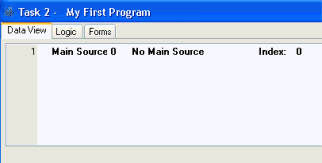Defining the Task Data View (Magic xpa 3.x)
The Task Editor should now be open. If it's not, then zoom (press F5) from the My First Program.

The Task interface is composed of three editors: Data View, Logic, and Forms.
In this topic, we'll discuss the Data View Editor.
In the Data View Editor, you can create two types of lines:
-
Header line – The header line defines the task's data source types and properties. The first header line defines whether the task has a Main data source or a Direct SQL statement.
-
Detail line – The detail line defines the task's variables. The variables can be data source columns, parameters, or Virtual variables.
Now you will define the new program data view, which is composed of Virtual variables. Later on, you will learn how to define other sources in the data view.
A Virtual variable is a local variable that is used for computation and temporary storage. The Virtual variable exists only for the program duration, so its value is not saved after the program execution is terminated. This means that in each execution, the values of the variables return to their default values.
-
Verify that you are parked on the Data View Editor.
-
Create a line (either by selecting from the Edit menu or pressing F4) for each variable.
-
Set the information as you see in the image below.

Now, we will create a form to display the customer codes and customer names.

